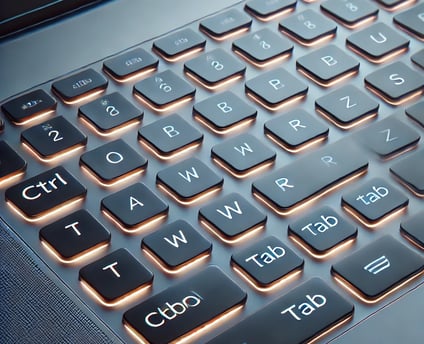Types of Keyboard Layouts: QWERTY, Dvorak, AZERTY, Colemak
Types of Keyboard Layouts: QWERTY, Dvorak, AZERTY, Colemak ,
3/5/20253 min read


The keyboard is one of the most essential input devices, and its layout significantly affects typing speed, comfort, and efficiency. While most people are familiar with the QWERTY layout, there are several alternative layouts like Dvorak, AZERTY, and Colemak, each designed with different objectives in mind.
1. QWERTY Keyboard Layout
History and Origin
The QWERTY layout is the most widely used keyboard layout in the world. It was developed by Christopher Latham Sholes in the 1870s for typewriters and became the standard for computer keyboards. The name "QWERTY" comes from the first six letters in the top-left row of the keyboard.
Why Was QWERTY Designed?
The QWERTY layout was created to address mechanical issues in early typewriters. By spacing commonly used letters apart, it reduced the likelihood of key jamming when typing quickly. Over time, it became the industry standard, and even though modern keyboards no longer have mechanical constraints, QWERTY remains dominant due to widespread adoption.
Advantages of QWERTY
Universally recognized and available on almost all keyboards.
Easy to learn because it is the default layout for most people.
Supported by all operating systems and devices.
Disadvantages of QWERTY
Not the most efficient layout for typing speed and comfort.
High finger movement can lead to more strain over long typing sessions.
Not optimized for ergonomics and can contribute to repetitive strain injuries (RSI).
Who Should Use QWERTY?
Anyone who wants a widely available and familiar layout.
People who do not want to relearn typing with a different layout.


2. Dvorak Keyboard Layout
History and Origin
The Dvorak Simplified Keyboard was designed by Dr. August Dvorak and his brother-in-law Dr. William Dealey in the 1930s. It was created to improve typing efficiency by placing the most commonly used letters under the strongest fingers.
Why Was Dvorak Designed?
The goal of the Dvorak layout was to reduce finger movement and increase typing speed while minimizing fatigue. Unlike QWERTY, which was designed for typewriters, Dvorak focuses on ergonomics and efficiency.
Advantages of Dvorak
Less finger movement, reducing strain and increasing typing comfort.
Commonly used vowels and consonants are placed on the home row, improving speed.
Designed to reduce repetitive strain injuries (RSI).
Disadvantages of Dvorak
Not widely supported by default on many systems.
Difficult to switch to after learning QWERTY.
Limited availability on physical keyboards.
Who Should Use Dvorak?
People who experience wrist pain or RSI and need a more ergonomic layout.
Typists and programmers who want to increase speed and efficiency.
Those willing to relearn typing for long-term benefits.
3. AZERTY Keyboard Layout
History and Origin
The AZERTY layout is the standard keyboard layout used in France and Belgium. It was developed as an alternative to QWERTY to accommodate the French language, which has different letter frequency patterns.
Why Was AZERTY Designed?
French has special characters and accents that are not as easily accessible on a QWERTY keyboard. AZERTY reorganizes keys to make typing in French more natural.
Advantages of AZERTY
Optimized for French-language typing.
Easier access to accented letters like é, è, and à.
Commonly used in France and French-speaking regions.
Disadvantages of AZERTY
Not ideal for English typing due to key placement.
Less ergonomic than QWERTY and Dvorak.
Limited global availability, making it harder to switch between devices.
Who Should Use AZERTY?
French speakers who frequently type in their native language.
People living in France or Belgium where AZERTY keyboards are standard.
4. Colemak Keyboard Layout
History and Origin
The Colemak layout was created in 2006 by Shai Coleman as an improved alternative to both QWERTY and Dvorak. It aims to reduce finger movement while maintaining some familiarity with QWERTY.
Why Was Colemak Designed?
Colemak was designed to be a more ergonomic and efficient alternative to QWERTY while keeping many key placements the same. This makes it easier to learn compared to Dvorak, which requires a complete retraining of typing habits.
Advantages of Colemak
More efficient and ergonomic than QWERTY.
Less finger movement, reducing typing fatigue.
Easier to learn than Dvorak, as many key placements are similar to QWERTY.
Supported on most modern operating systems.
Disadvantages of Colemak
Not as widely available as QWERTY.
Requires some adjustment period when switching from QWERTY.
Limited support on physical keyboards, as most keyboards come pre-configured for QWERTY.
Who Should Use Colemak?
People looking for a more comfortable and ergonomic layout.
Those who want to type faster with less strain on fingers.
Anyone willing to take the time to adjust from QWERTY but doesn’t want a drastic change like Dvorak.
mr.Udit kumar
info@worldbesthub.com
+91-8920162717
Contact Us
Keyboard Basics & Functions
Keyboard Shortcuts & Productivity
Gaming Keyboards & Features
